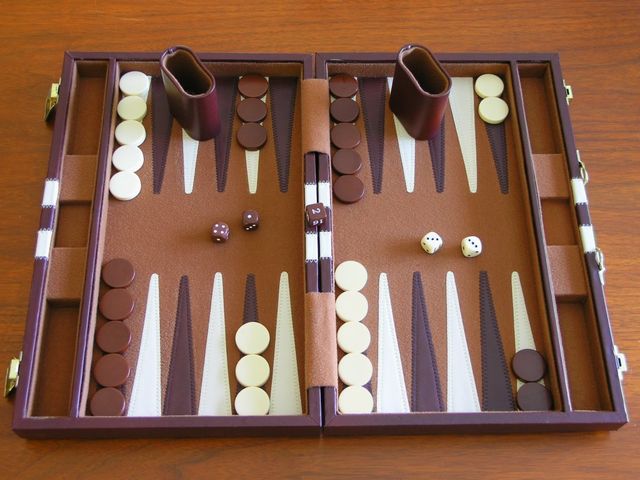No Shabbat dinner at my uncle’s place is complete without a melodramatic backgammon game. Let me set the stage: Clicking sounds from the backgammon checkers hitting the backgammon board grow louder and louder as the checkers make their way around the board. My aunt calls out from the kitchen, insisting the crowd watching the game reconvenes at the dining table for dinner, but my uncle pleads for just a few more minutes. Suddenly, the room is quiet, signaling a turning point in the game.
Tensions rise as he gently shakes the glistening dice in the palm of his right hand. Subtle screeching noises come from onlookers inching their wooden chairs forward for a closer look. The only discernible noise comes from my uncle’s mouth as he repeatedly murmurs “joft sheesh” (double six) under his breath, his eyes fixated on the backgammon board. He rolls the dice, and within seconds, all are on their feet cheering. He rolled a joft sheesh.
Undoubtedly, you can find a backgammon board in every one of my extended family members’ homes. Besides Persian rugs, glass tea sets, and jars of saffron, it is commonplace for a Persian household to carry a backgammon board, if not a whole backgammon table with matching chairs. In adolescence, we observe from a distance as our elders maneuver their checkers along the backgammon board and occasionally blow on the dice for good luck; when we grow older, we learn to play on our own, hoping to one day be worthy opponents to our elders. The game requires just the right balance between skill and luck, and even the most skilled player can find himself in a losing situation, making the game all the more thrilling to both play and watch.
Backgammon is among the most ancient board games known to man. Tabula, a precursor to backgammon (played with three, rather than two, dice), was first documented in an epigram of the Byzantine Emperor Zeno in the fifth century. Although the renowned Persian poet Ferdowsi dates the invention of “nard” (backgammon in Farsi) to the sixth century, excavations from a city in Iran trace the existence of a similar board game back to 3000 BCE. Historians even claim that the earliest mention of nard comes from the Talmud. Although backgammon is commonly known as a Middle Eastern game today, it was well-known in other parts of the world, such as Sweden, Greece, Iceland, Spain and Turkey, as early as the 11th century.
Yet, backgammon was not always respected. In fact, in his commentary on the Mishnah, Maimonides disapproved of nard for its similarity in nature to gambling. Games such as backgammon were seen as a waste of time. However, board games soon became increasingly more acceptable and backgammon has since become an admirable pastime, as it is for Sephardic Jews on Shabbat. Indeed, backgammon entails no halachic problem, as Shemirat Shabbat Ke’Hilchata permits using dice on Shabbat, therefore making backgammon a seemly Shabbat activity.
On May 22, JIMENA (Jews Indigenous to the Middle East and North Africa) and STTI (Sephardic Temple Tifereth Israel) will host their second annual Community Backgammon Day. By paying a $10 entree fee, you will be able to watch the tournament and enjoy Mizrachi music and lunch. A $20 fee in advance (or $30 at the door) will also allow you to participate in the tournament, and possibly go home with the prizes allotted to the winners. With last year’s event proving to be a hit, this year’s backgammon day promises to amuse. I encourage all backgammon players alike to spend the afternoon exhibiting their own skills and appreciating those of others in the community. May we all roll joft sheesh!

